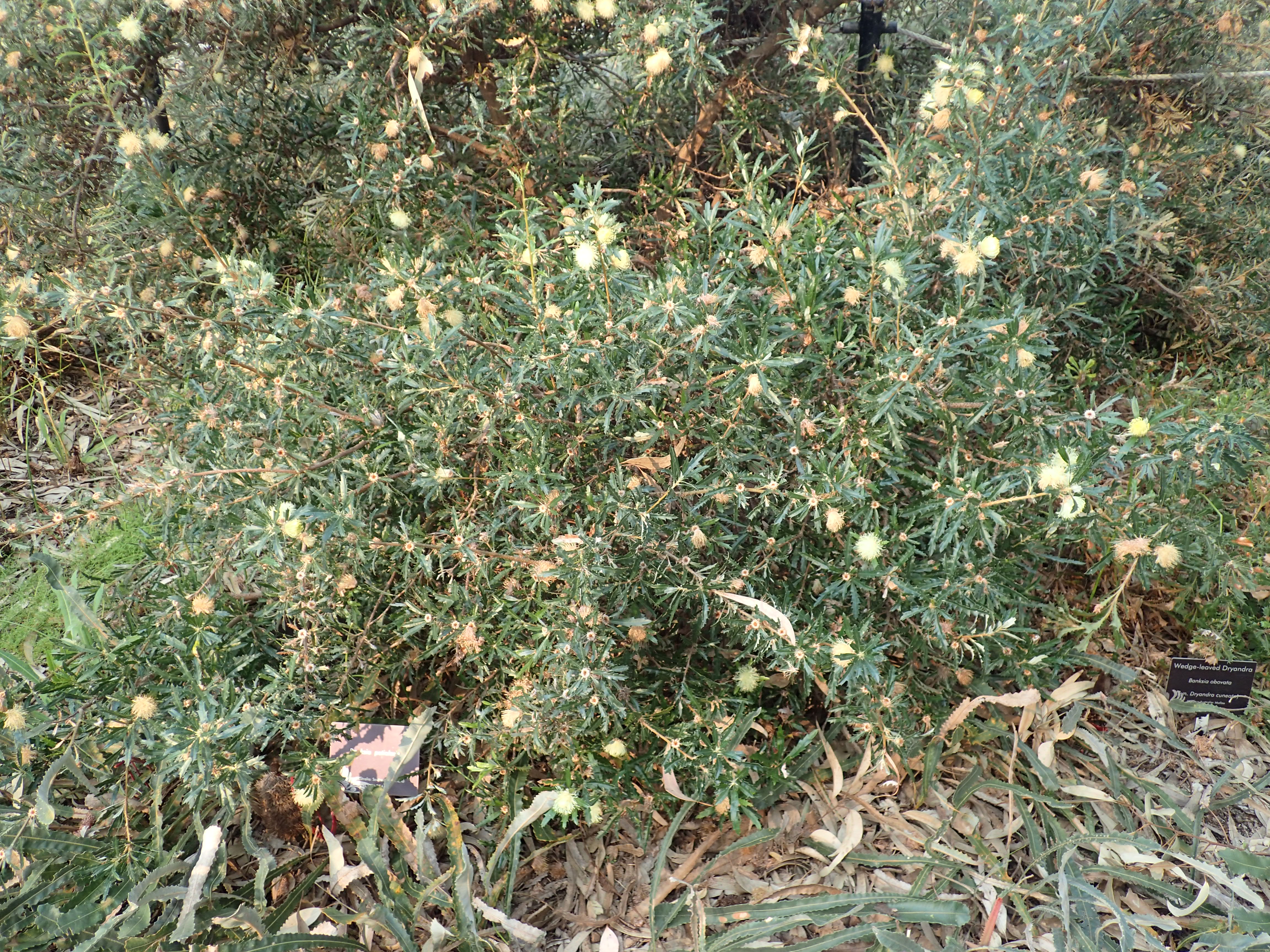Banksia Obovata on:
[Wikipedia]
[Google]
[Amazon]
 ''Banksia obovata'', commonly known as wedge-leaved dryandra, is a species of shrub that is
''Banksia obovata'', commonly known as wedge-leaved dryandra, is a species of shrub that is
 ''Banksia obovata'', commonly known as wedge-leaved dryandra, is a species of shrub that is
''Banksia obovata'', commonly known as wedge-leaved dryandra, is a species of shrub that is endemic
Endemism is the state of a species being found in a single defined geographic location, such as an island, state, nation, country or other defined zone; organisms that are indigenous to a place are not endemic to it if they are also found elsew ...
to Western Australia. It has hairy stems, serrated, wedge-shaped to egg-shaped leaves with the lower end towards the base, cream-coloured or pale yellow flowers in heads of up to 100, and egg-shaped follicles. It is found in near-coastal areas in the south of the state.
Description
''Banksia obovata'' is a shrub that typically grows to a height of but does not form alignotuber
A lignotuber is a woody swelling of the root crown possessed by some plants as a protection against destruction of the plant stem, such as by fire. Other woody plants may develop basal burls as a similar survival strategy, often as a response t ...
. It has wedge-shaped to egg-shaped leaves with the narrower end at the base, long and wide on a petiole up to long, with between four and twelve serrations on each side. Between thirty-five and one hundred cream-coloured or pale yellow flowers are borne in a head with linear to egg-shaped involucral bracts up to long at the base of the head. The perianth
The perianth (perigonium, perigon or perigone in monocots) is the non-reproductive part of the flower, and structure that forms an envelope surrounding the sexual organs, consisting of the calyx (sepals) and the corolla (petals) or tepals when ...
is long and the pistil
Gynoecium (; ) is most commonly used as a collective term for the parts of a flower that produce ovules and ultimately develop into the fruit and seeds. The gynoecium is the innermost whorl of a flower; it consists of (one or more) ''pistils'' ...
long. Flowering occurs mainly occurs from April to November, but also in other months and the follicles are egg-shaped, long.
Taxonomy and naming
This species was first formally described in 1810 by Robert Brown in ''Transactions of the Linnean Society of London
The Linnean Society of London is a learned society dedicated to the study and dissemination of information concerning natural history, evolution, and taxonomy. It possesses several important biological specimen, manuscript and literature colle ...
'' and was given the name ''Dryandra cuneata''. The specific epithet
In taxonomy, binomial nomenclature ("two-term naming system"), also called nomenclature ("two-name naming system") or binary nomenclature, is a formal system of naming species of living things by giving each a name composed of two parts, bot ...
(''cuneata'') is a Latin word meaning wedge-shaped.
In 2007, Austin Mast Austin R. Mast is a research botanist. Born in 1972, he obtained a Ph.D. from the University of Wisconsin–Madison in 2000. He is currently a professor within the Department of Biological Science at Florida State University (FSU), and has been dire ...
and Kevin Thiele
Kevin R. Thiele is currently an adjunct associate professor at the University of Western Australia and the director of Taxonomy Australia. He was the curator of the Western Australian Herbarium from 2006 to 2015. His research interests include ...
transferred all dryandras to the genus ''Banksia''. As there was already a plant named ''Banksia cuneata
''Banksia cuneata'', commonly known as matchstick banksia or Quairading banksia, is an endangered species of flowering plant in the family Proteaceae. Endemic to Southwest Australia, southwest Western Australia, it belongs to Banksia subg. Isos ...
'' (matchstick banksia), Mast and Thiele chose the epithet ''obovata'', meaning "inverted egg-shaped, in reference to the obovate
The following is a list of terms which are used to describe leaf morphology in the description and taxonomy of plants. Leaves may be simple (a single leaf blade or lamina) or compound (with several leaflets). The edge of the leaf may be regular o ...
leaves.
Distribution and habitat
Wedge-leaved dryandra occurs near the south coast of Western Australia between Narrogin, Albany and theCape Arid National Park
Cape Arid National Park is a List of national parks of Australia, national park located in Western Australia, southeast of Perth. The park is situated east of Esperance, Western Australia, Esperance and lies on the shore of the South coast of W ...
, including in the Stirling Range
The Stirling Range or Koikyennuruff is a range of mountains and hills in the Great Southern region of Western Australia, south-east of Perth. It is over wide from west to east, stretching from the highway between Mount Barker and Cranb ...
. It grows in kwongan
Kwongan is plant community found in south-western Western Australia. The name is a Bibbelmun (Noongar) Aboriginal term of wide geographical use defined by Beard (1976) as
Kwongan has replaced other terms applied by European botanists such as ...
.
References
* {{Taxonbar, from=Q51042904, from2=Q4856660 obovata Plants described in 1810 Taxa named by Robert Brown (botanist, born 1773)